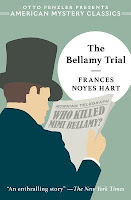A rational college professor inherits a house that may be haunted, or worse.
Mystery Review: The Red Lamp leaves the reader wondering: is it a ghost story or a romance, is it the supernatural or is there a rational explanation for the odd goings on, and what about the mystical red lamp? There's a Wilkie Collins feel to this novel. Clumsily written in journal entries that can slow the pace, we gradually learn all as the narrator fears that he's the police's main suspect in various mysterious deaths. Red herrings abound. The characters are not well developed, and some faded into anonymity including the main suspects and the narrator's wife. There is no effective detective except for the romantic lead who's working overtime. The Red Lamp includes a little bit of shy romance, with nary a kiss, but a bit of (hundred year ago) Twenties banter. Mary Roberts Rinehart (1876-1958) was sometimes called the American Agatha Christie (though she wasn't the only one, see Mignon Eberhart), and while she may have been as productive and successful as Christie in her time, her work is not as effective or convincing as to warrant that title. She did, however, enjoy writing frequently about spooky old houses and the mysterious, possibly supernatural, deaths of the old folks who owned them. Despite that, The Red Lamp was too all over the place to be more than only adequate entertainment. [3★]























